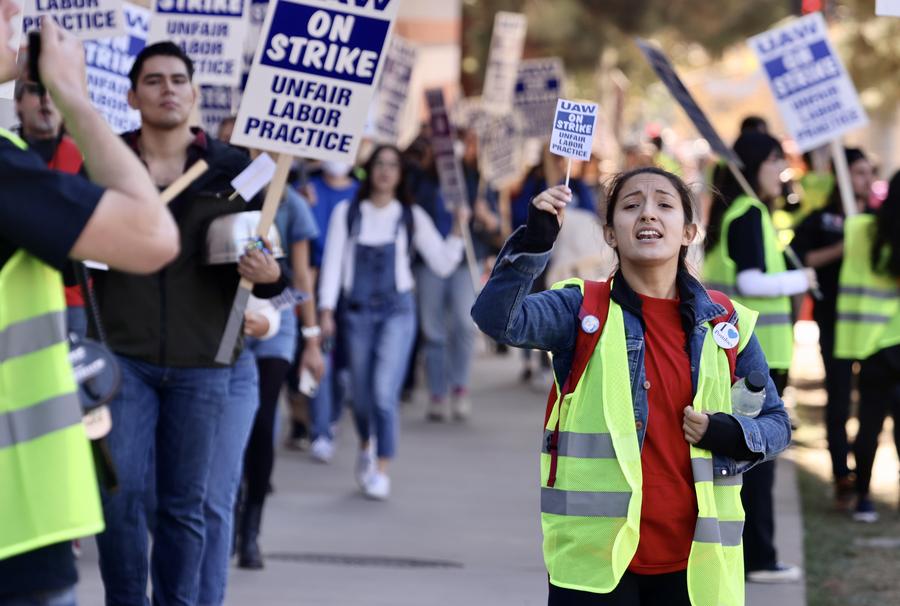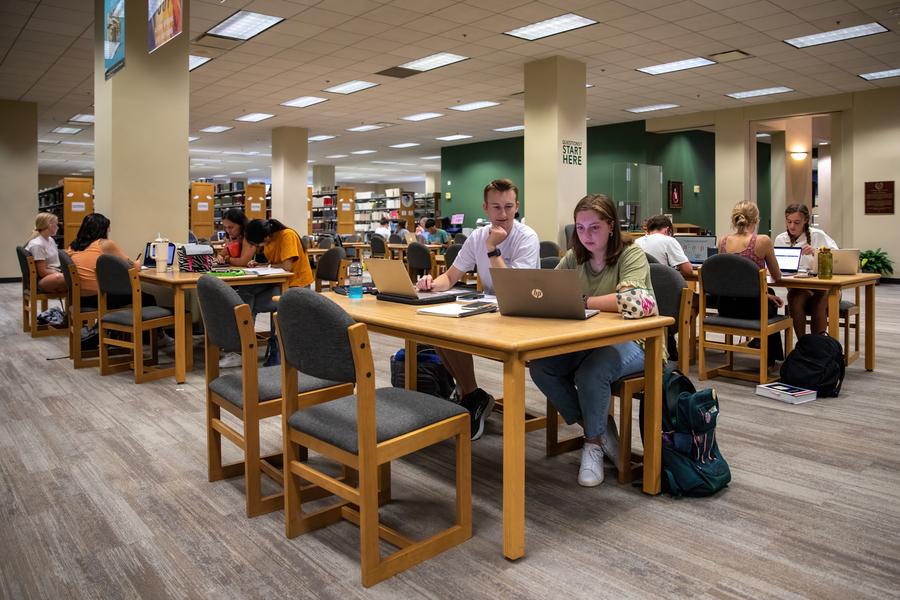Explainer: How student loan debt turns into crushing crisis in U.S.

A work-study student restocks a bookshelf with books that students have returned at Baylor University in Waco, Texas, the United States, on Aug. 28, 2022. (Photo by Xin Jin/Xinhua)
The student debt, which constitutes the largest non-mortgage liability for U.S. households, is the result of a decades-long explosion in borrowing coupled with soaring education costs, which have outpaced the inflation rate.
BEIJING, April 9 (Xinhua) -- U.S. President Joe Biden on Monday announced a new, sweeping student loan forgiveness plan to help "working- and middle-class folks to repay their student loans" that "has become so burdensome, (that) a lot can't repay it for even decades after being in school."
"Too many people feel the strain and stress wondering if they can get married, have their first child, start a family, because even if they get by they still have this crushing, crushing debt," the president said, hoping millions of Americans could benefit if the plan survives legal challenges.
While experts doubt the Biden program could solve the real problem, many ask: how has the student loan debt, a well-intended project established in the 1950s to help students access higher education and promote equal opportunity, evolved into a trillion-dollar crisis?

People take part in a protest on campus of the University of California, Los Angeles (UCLA) in Los Angeles, California, the United States, on Nov. 14. 2022. Tens of thousands of academic workers at the University of California (UC) system went on strike for higher wages and better working conditions. (Xinhua)
SOARING COLLEGE COSTS
An approximate 43.6 million Americans, or 17 percent of the country's adult population, have student loan debts, amassing to more than 1.6 trillion U.S. dollars by the end of last year, according to data from the Federal Reserve Bank of New York.
The student debt now constitutes the largest non-mortgage liability for U.S. households, accounting for 9 percent of U.S. consumer debt, according to the U.S. Bankrate website.
That's the result of a decades-long explosion in borrowing coupled with soaring education costs, which have outpaced the inflation rate, experts say.
According to data from the National Center for Education Statistics, in the 1968-1969 academic year, adjusted for inflation, it cost 1,545 dollars to attend a public, four-year institution, including tuition, fees, room and board. In the 2020-2021 school year, the amount rose to 29,033 dollars. If costs stayed in line with inflation, going to a four-year college should only need about 12,000 dollars a year.
In the 2020-2021 academic year, 51 percent of students who graduated from public four-year institutions left with federal debt averaging more than 21,000 dollars per person. That figure is slightly higher for those who went to a private institution, with 53 percent graduating with federal debt averaging more than 22,000 dollars, according to the U.S. College Board.

Students are seen at a library of Baylor University in Waco, Texas, the United States, on Aug. 28, 2022. (Photo by Xin Jin/Xinhua)
DECADES NEEDED TO REPAY
Meanwhile, high interest rates, tight repayment terms and an increasingly competitive labor market have left a large number of Americans with student loans unable to make enough money to pay off the accumulated interest, let alone repay the principal.
According to data from the Bankrate website in December 2023, the current annual interest rate of federal student loans ranges from 5.50 percent to 8.05 percent, in addition to the charging of considerable loan fees. The average annual interest rate on private student loans can be as high as 17 percent.
The Education Data Initiative says an average student loan borrower in the United States takes 20 years to pay off those debts while some graduates of certain professional fields take an average of 45 years to pay off their student loans.
Around 40 percent of borrowers never graduate from school in the first place. And a third of the debt will never be paid off, according to the Department of Education. Bankrate reports that more than half of American adults agree that "the cost of college has gotten out of control."
"The astronomical level of student debt accrued in the United States is inflicting lasting, generational damage on the lives of millions of Americans," said The New York Times in a report.
Adam Looney, a senior fellow at the Brookings Institution, said the borrowers struggling with student loans are more likely to come from low-income families and people of color. According to data released by the Education Data Initiative in December 2023, African-American students borrow an average of 25,000 dollars more than white students.
The burden of student loan debts in the United States has reached "crisis" levels, with students of color disproportionately burdened. Racial disparities in student debts not only have short-term effects, but also create long-term inequalities that affect educational and socioeconomic equity throughout a student's lifetime and for generations to come, warns the National Association for the Advancement of Colored People.

U.S. President Barack Obama makes a statement on student loans in the Rose Garden of the White House in Washington, D.C. on May 31, 2013. Obama called on Congress to help keep college affordable for middle-class families and students by preventing student loan interest rates from doubling. (Xinhua/Fang Zhe)
SHATTERED COLLEGE SYSTEM
Experts have pointed out that student loan forgiveness plans cannot solve the systemic problems of the U.S. high education. These programs miss "the fundamental weaknesses of higher education, namely an unacceptably low completion rate, overdependence on loans to attend college, and high and rapidly increasing costs," writes Roger Ferguson from the Council on Foreign Relations, an American think tank specializing in U.S. foreign policy and international relations.
According to a report by the U.S. National Education Association, 32 U.S. states are spending less on public colleges and universities than they did in 2008. The lack of government investment has led universities to rely on student tuition fees to cover their running costs, and students to borrow money to cover rising university costs.
"The Biden administration should spend its finite resources and political capital on fixing the higher education system to make it more affordable while helping those borrowers in the most distress," said The New York Times.
Wang Congyue, an associate researcher at the Institute of American Studies at the Chinese Academy of Social Sciences, said that the problem of student loans in the United States is directly related to loopholes in educational policies, as colleges and banks have formed interest groups, profiting by raising tuition costs and offering loans to students.
Although both the Democratic and Republican parties agree that college tuition has been rising to an unreasonably high level and the student loan system is in urgent need of reform, they are at odds over specific solutions and reform guidelines.
"The student loan issue in the United States has been highly politicized and instrumentalized. Education issues have become a tool for both parties to attack each other. To change the status quo will meet a lot of resistance," he said.
Photos
Related Stories
- War-left U.S. aerial bomb safely removed in Cambodia's coastal province: official
- Solar eclipse spotted in U.S.
- Wrong for doing the right thing: How the Western media deliberately demonizes China
- U.S. most recent absurd accusation: China-made cranes are spies
- Shooting leaves 3 dead, including shooter, in U.S. Las Vegas
Copyright © 2024 People's Daily Online. All Rights Reserved.









